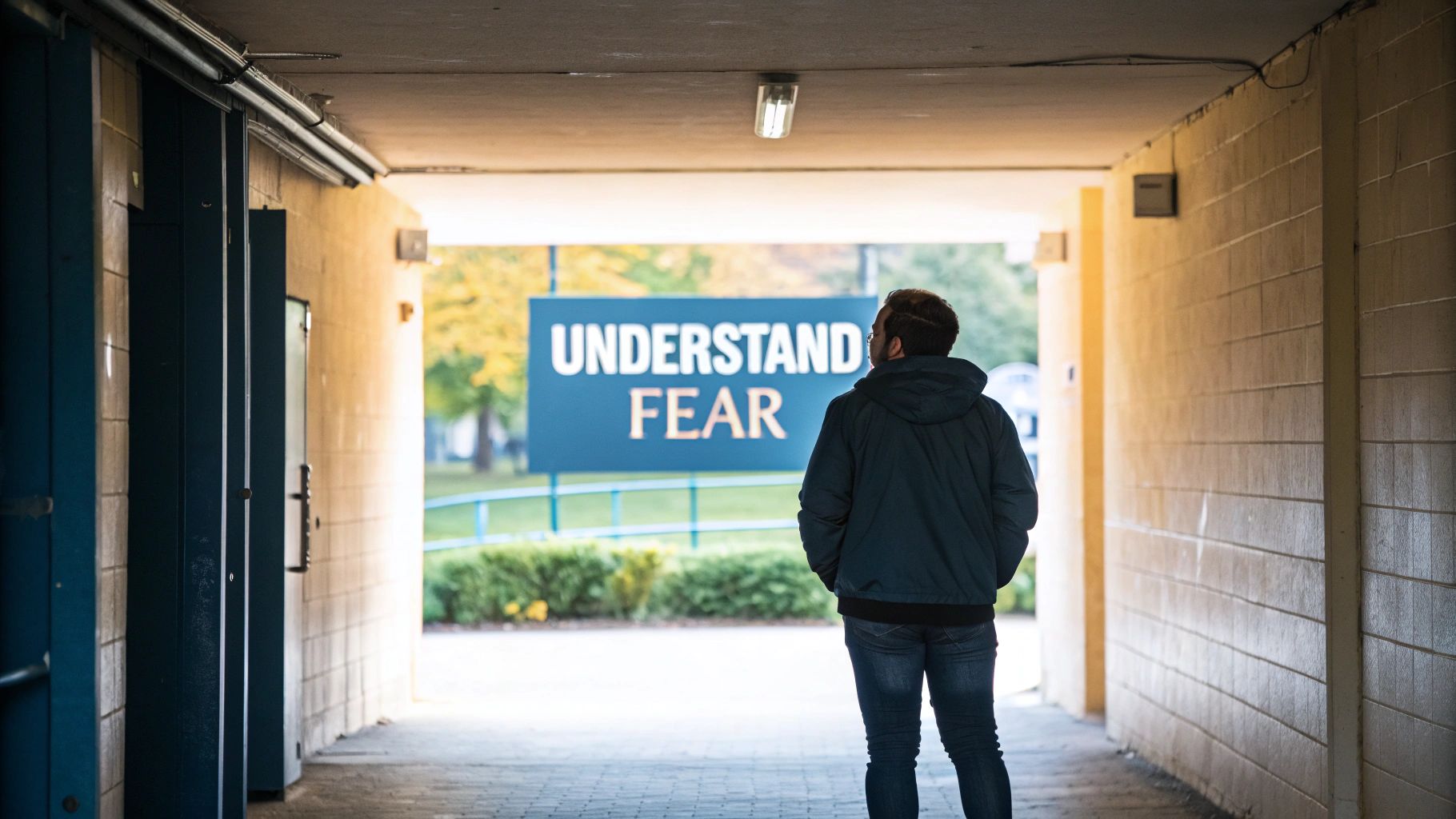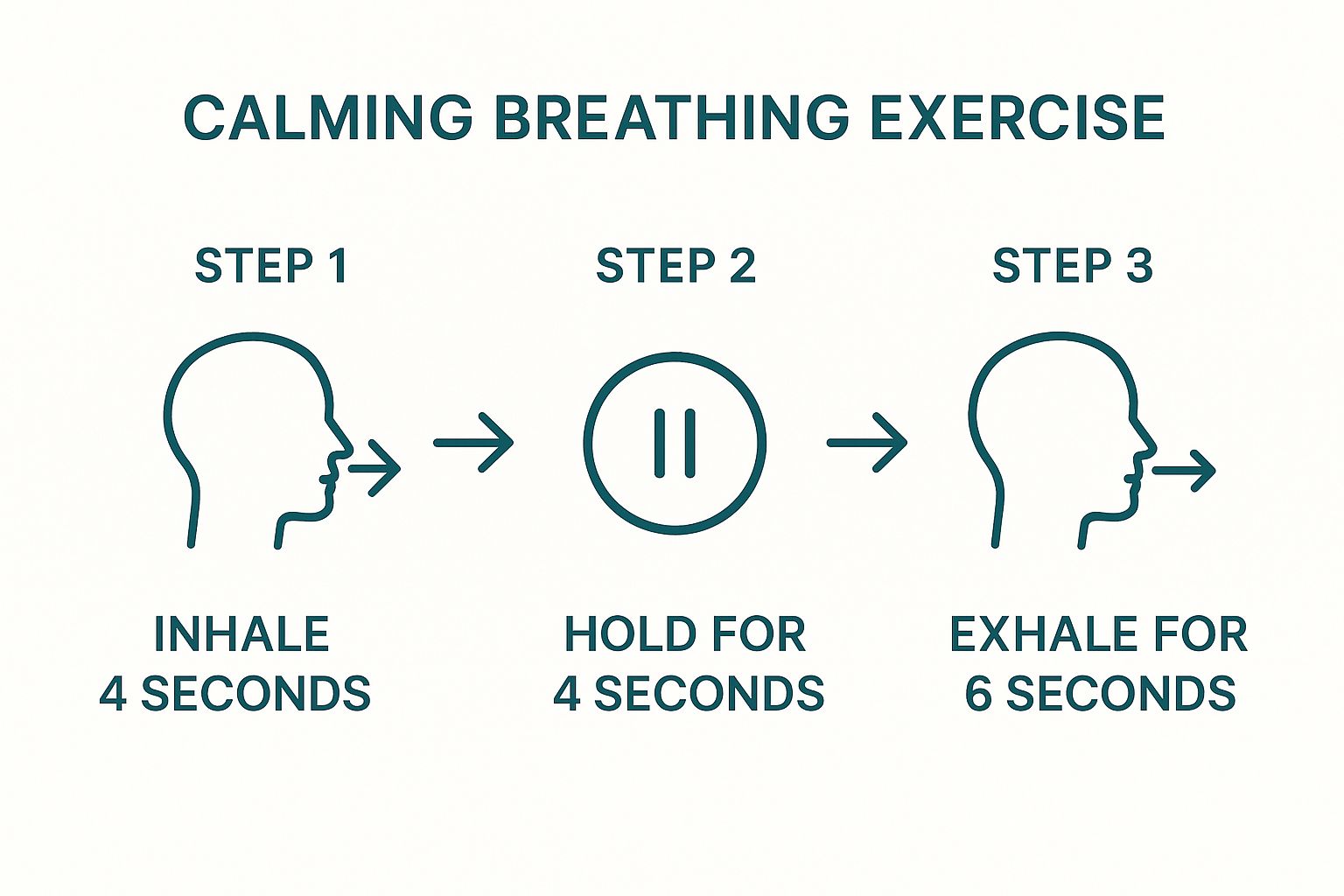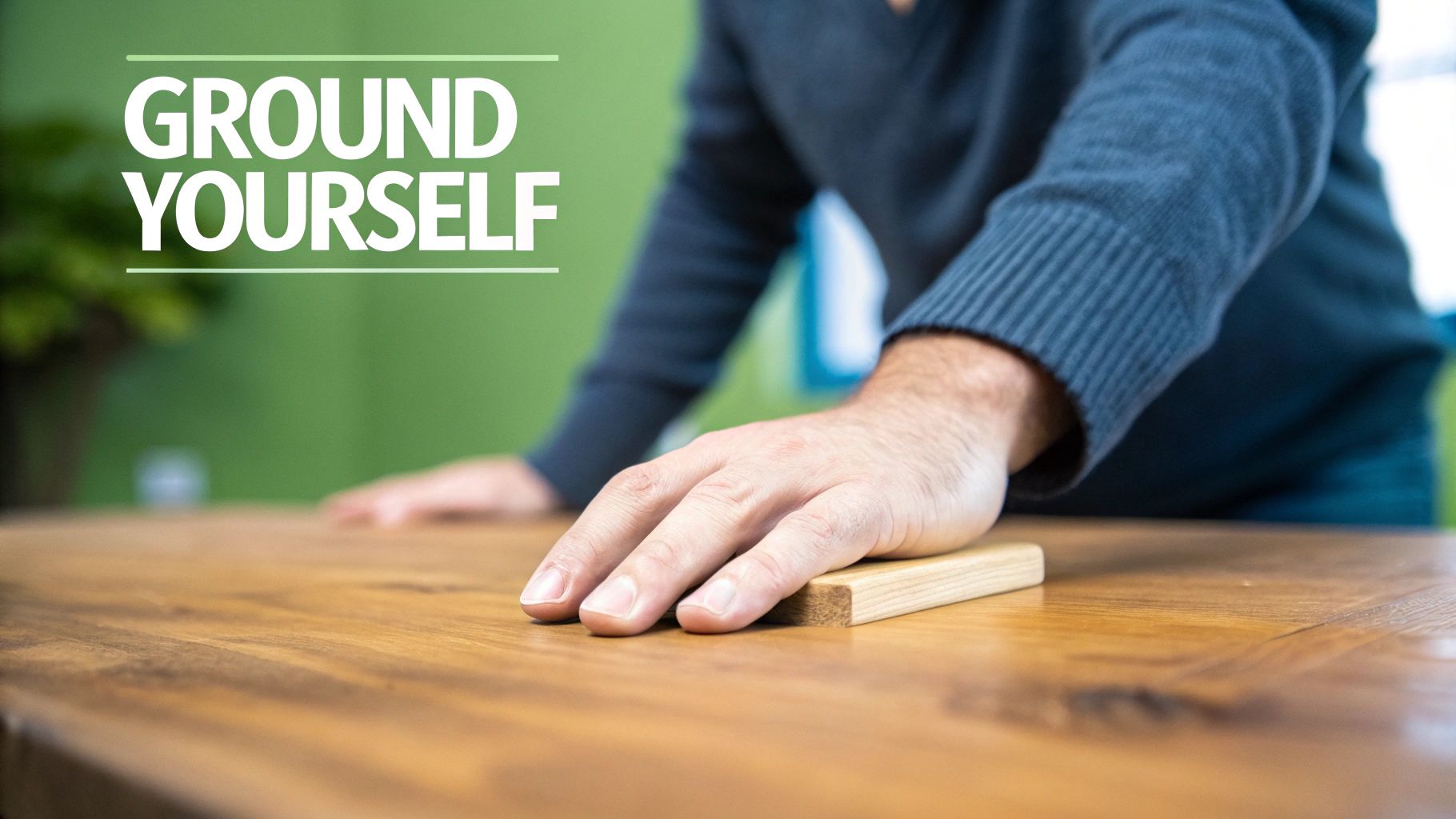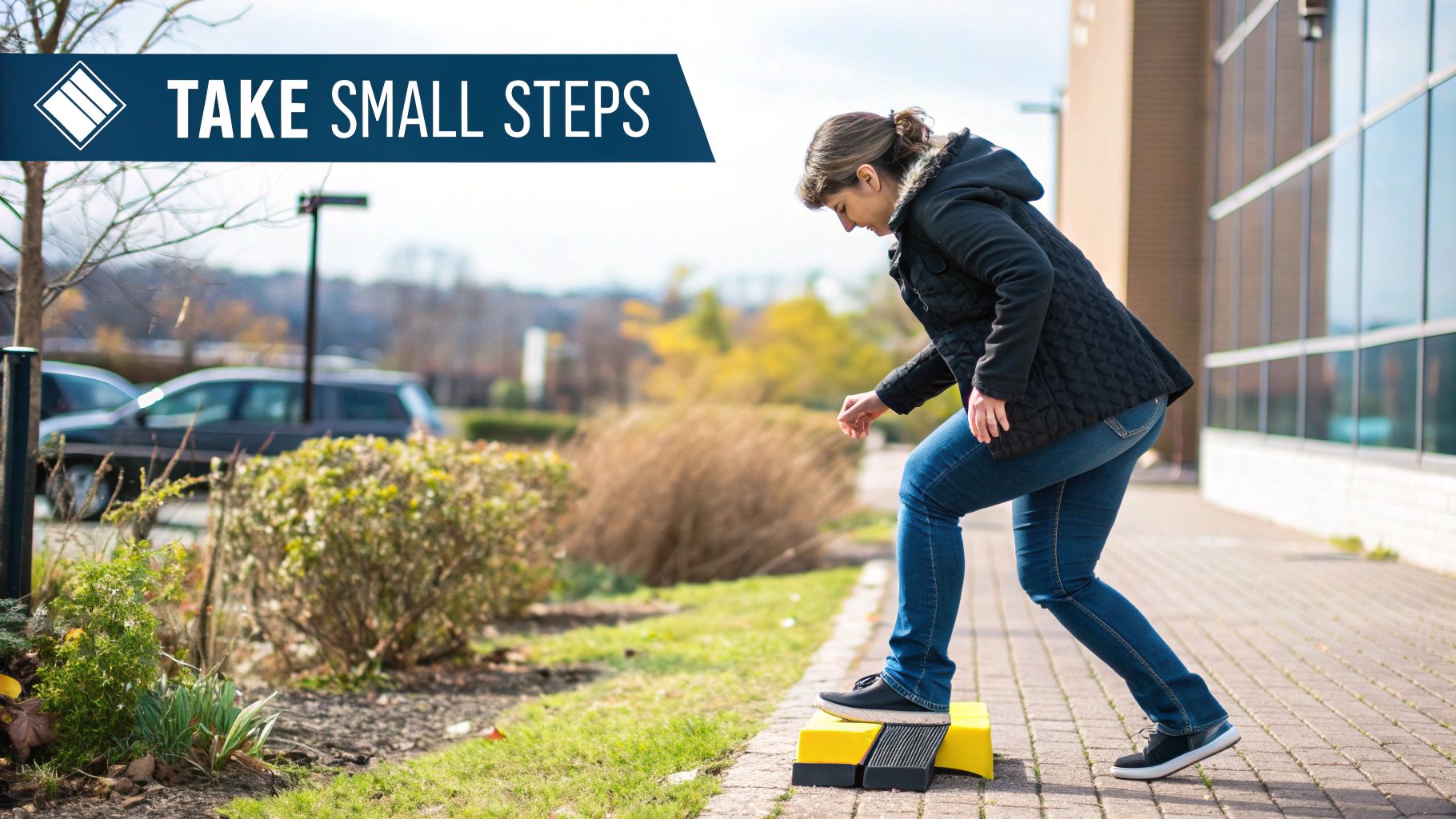.webp)
First things first, let's get one thing straight: feeling scared is a completely normal, protective human response. It’s not a weakness. The trick is learning to tell the difference between rational fears that genuinely keep you safe and irrational anxieties that just hold you back.
Once you can spot the difference, you can start managing your reaction. That feeling of panic can become a manageable signal from your body, not a command to shut down. This shift in perspective is the absolute key to regaining control.

Feeling scared is wired into us. At its core, fear is an ancient survival mechanism—a biological alarm system designed to scream "danger!" when you need it most. When a car swerves towards you, that response is invaluable. It triggers the classic "fight or flight" reaction, flooding your body with adrenaline to help you react in a split second.
The trouble starts when this system gets a bit overactive. Your brain can start perceiving threats where none really exist, making you feel scared in situations that aren't actually dangerous. This is where we separate fear from anxiety. Fear is a direct response to a clear and present danger, while anxiety is often a reaction to a potential, imagined, or far-off threat.
If you feel this way, it's crucial to realise you’re not alone. In the UK, anxiety is one of the most widespread mental health challenges we face.
Recent data from the Office for National Statistics revealed that around 23% of working-age adults reported experiencing high anxiety, a noticeable jump from pre-pandemic figures. Feeling overwhelmed by fear or worry is a shared experience for millions.
Instead of seeing it as some personal failure, it’s far more helpful to view it as a common human condition, especially in the high-stress world we live in. Shifting your mindset is a powerful first step; when you stop judging yourself for feeling scared, you create the space to start addressing it constructively.
"Fear is a natural response, but it doesn't have to be the director of your life. The goal isn't to eliminate fear entirely, but to learn how to act bravely in spite of it."
A huge part of learning how to not be scared is about changing your internal dialogue. Fearful thoughts often run on autopilot, spinning worst-case scenarios that feel incredibly real. The key is to consciously step in and challenge those narratives.
Think about a big presentation at work. Your mind might immediately jump to, "I'm going to fail, and everyone will think I'm incompetent." A simple reframe can completely shift this perspective.
This practice of reframing isn’t about pretending your feelings don't exist. It's about questioning their validity and separating the emotional reaction from the objective reality of the situation. To give you a head start, here’s a quick guide to challenging some common fearful thoughts.
Practising these reframes helps build new mental habits, making it easier to manage fear when it pops up. It’s a skill, and like any skill, it gets stronger with use.
By understanding why you feel scared and actively working to reframe those thoughts, you begin to dismantle fear's power over you. For more strategies on improving your mental state, feel free to explore our other resources on overall well-being.
When fear hits, it's a full-body experience. Your heart hammers against your ribs, your breathing turns shallow, and your thoughts can easily spiral. The key to navigating these moments isn't to pretend you're not scared, but to have a toolkit of real, immediate techniques that can pull you back from the edge.
These methods are designed to interrupt the body's acute stress response—what we all know as "fight or flight." By calming your physical self first, you send a clear message to your brain that the immediate danger has passed. This allows your rational, thinking mind to come back online. Best of all, you don't need any special equipment. These are tools you can use anywhere, anytime.
One of the quickest ways to soothe a frazzled nervous system is through your breath. When you're scared, you instinctively take quick, shallow breaths, which only fuels the feeling of panic. Deliberate, slow breathing does the exact opposite; it activates the parasympathetic nervous system, which is your body's "rest and digest" mode.
A simple but incredibly powerful method is the 4-7-8 technique. You just breathe in for four seconds, hold for seven, and then exhale slowly for eight. That long exhale is the secret sauce—it physically slows your heart rate and can help lower your blood pressure, bringing an almost instant sense of calm.
The image below shows a similar, simplified breathing exercise you can try right now.

Think of it as using your breath as an anchor. It creates a steady rhythm that your mind and body can sync up with, pulling you out of the chaos of panic.
Fear loves to drag our minds into the future, obsessing over what might happen. A powerful way to fight back is to yank your focus firmly into the present with a grounding technique. The 5-4-3-2-1 method is brilliant for this.
It works by forcing your brain to engage with your senses and reconnect with your immediate surroundings, leaving little room for anxious thoughts to take hold.
Here’s the breakdown:
This sensory scan pulls your attention away from internal panic and roots you in the reality of the here and now. For many, creating a peaceful atmosphere with things like stress relief candles for relaxation can also make a huge difference in calming both mind and body.
By focusing on concrete sensory details, you are telling your brain, "I am here, I am safe, and I am in control." It's a mental reset button.
Your body language has a direct line to your emotional state. When we're scared, we instinctively hunch over, clench our jaw, and tense our muscles. You can actually work backwards by intentionally changing your posture to send calming signals to your brain.
Try this:
These small physical shifts are powerful interruptions. They disrupt the feedback loop where a tense body signals danger to the brain, which in turn creates even more tension. Learning to manage these physical responses is a cornerstone of well-being. If you're looking for more ideas, our guide on managing stress offers practical strategies for a calmer life.
These immediate actions give you a sense of control right when you feel most powerless, forming your first line of defence against overwhelming fear.

While quick fixes are great for managing a sudden wave of panic, the real work in learning how to not be scared is a long game. It's about building a solid mental and physical foundation that makes you less vulnerable to fear’s influence from the start.
Think of it as strengthening your emotional immune system. The goal isn't to get rid of fear entirely—it's to create sustainable habits that fortify your mind over weeks and months, making it much harder for fear to take control.
Mindfulness meditation is one of the most powerful tools in your long-term arsenal. The aim isn't to empty your mind, which is almost impossible, but to fundamentally change your relationship with your thoughts. With regular practice, you learn to see your fears from a distance, without getting tangled up in their narratives.
Instead of being inside the storm of a scary thought, you become the calm observer watching it pass. This simple shift is a game-changer. It teaches you that a fearful thought is just that—a thought. It’s not an order or an undeniable truth. Just 5-10 minutes a day can start to rewire how your brain responds to triggers.
It's a huge step, but remember, you're not alone in this. Mental health issues affect around 1 in 4 adults in England each year, and the challenges are particularly common for young adults. If you're finding things tough, know that many others are, too. You can learn more about UK mental health statistics on Priory Group.
It sounds like the last thing you'd want to do, but one of the most effective ways to shrink a fear is to face it. This doesn't mean jumping in at the deep end. The secret is gradual exposure—tackling your fear in small, manageable, and controlled steps.
Let's say you have a fear of public speaking. An exposure ladder might look something like this:
Each rung on the ladder builds confidence and shows your brain that the catastrophe you’re imagining is unlikely to happen. You're slowly dismantling the fear with cold, hard evidence of your own capability. It can be a slow process, but the results are profound. For deeper-seated fears or trauma, therapies like EMDR offer structured approaches to processing difficult experiences.
The goal of gradual exposure is not to be fearless. It is to learn that you can be scared and still do the thing you need to do. That is the essence of courage.
Your mental resilience and physical health are deeply intertwined. If you neglect your body, you make your mind a much easier target for anxiety and fear. There are three non-negotiables for fortifying your emotional regulation.
1. Consistent Physical Activity
Exercise is one of nature’s most potent anxiety-reducers. It burns off the stress hormones adrenaline and cortisol while boosting mood-lifting endorphins. You don’t need to train for a marathon—a brisk 30-minute walk, a bike ride, or a yoga class makes a massive difference to your baseline anxiety.
2. A Balanced Diet
What you eat has a direct line to your brain function and mood. Highly processed foods and too much sugar can cause energy spikes and crashes that feel a lot like anxiety symptoms. Try to focus on a diet rich in whole foods:
3. Prioritising Quality Sleep
Sleep is when your brain gets to work processing emotions and recharging its batteries. A lack of good quality sleep tanks your emotional resilience, leaving you far more reactive to everyday stressors. Aim for 7-9 hours of quality sleep a night by creating a calm, consistent bedtime routine. These physical habits aren't just 'nice-to-haves'; they are essential tools for building a fear-resilient mind.
Fear rarely kicks the door down; it usually slips in through a crack in your thoughts. What starts as a quiet, nagging worry can quickly snowball, turning a small concern into a wave of panic. The real trick to learning how to not be scared is catching those thoughts before they gather steam and questioning whether they’re actually true.
This whole process is about becoming a detective of your own mind. It’s about spotting the sneaky, automatic thoughts—what experts call cognitive distortions—that fuel your anxiety and learning to put them on the stand. Think of it as building a new mental muscle.
First things first, you have to notice what’s happening. You can’t challenge a thought pattern if you don’t even realise it’s there. Often, these thoughts are so deeply ingrained they fly completely under the radar, leaving you with a knot in your stomach but no clear idea why.
A brilliant way to shine a light on them is to keep a simple ‘thought journal’. When you feel that jolt of fear, just pause and write down a few things:
Just writing it down creates a bit of space. It helps you see the thought for what it is—an event in your mind, not a proven fact. Over time, this simple practice helps you spot the recurring themes, like always jumping to the worst-case scenario or taking everything personally.
Once you’ve caught a fearful thought, it’s time to cross-examine it. Your mind can be a very convincing prosecutor, but you get to be the judge and jury. Start asking some direct, evidence-based questions to see if the thought really holds up.
Let’s take the classic fear of public speaking. The automatic thought might be: “If I stumble over my words, everyone will think I’m an idiot.”
Now, let’s challenge that in court:
This method is straight out of the Cognitive Behavioural Therapy playbook. It’s not about slapping on a fake-positive attitude; it’s about finding a more realistic perspective that sucks the power out of that initial scary thought. If you're keen to explore these techniques more formally, learning the foundations of CBT can be a massive help.
The goal is to shift from an emotional reaction to a rational response. You're not trying to ignore the fear—you're just refusing to let it run the show.
Fearful thinking isn't very original. It tends to fall into the same old irrational patterns, which psychologists call cognitive distortions. Once you can name them, you can dismiss them more easily.
Here's a quick look at some of the most common culprits.
Actively spotting these unhelpful patterns is a huge part of breaking the anxiety and avoidance cycle that keeps so many of us stuck.
By consistently challenging your thoughts, you're not just fighting fear in the moment. You are slowly but surely rewiring your brain's response, building a calmer, more resilient internal narrative one thought at a time.

The strategies we’ve covered are powerful tools for managing fear. But sometimes, self-help just isn't enough, and that's perfectly okay. Realising you might need a bit more support isn’t a sign of weakness—far from it. It's a sign of real strength and self-awareness.
Learning how to not be scared sometimes means knowing when to ask for help. If fear or anxiety starts getting in the way of your daily life, it might be time to think about professional support.
It can be tough to tell when "normal" worry crosses the line into something more serious. The key is to look at the impact fear is having on your ability to function and actually enjoy your life.
Here are a few signals that professional help could be a game-changer:
If any of this feels familiar, reaching out is a brave, proactive step toward feeling better. And you wouldn't be alone. Rising mental health pressures have led to a record number of referrals in England, which shows a clear trend of people actively seeking help to manage their wellbeing. You can learn more about these mental health trends from the British Medical Association.
Trying to figure out the healthcare system can feel a bit overwhelming, but getting started is usually more straightforward than you’d think. For most people in the UK, the journey begins with their local GP.
Your GP should be your first port of call. They can assess what's going on, talk through your options, and rule out any physical causes for your symptoms. Be as open and honest as you can; they are trained to handle these conversations with care and zero judgement.
From there, your GP can refer you to the right services. Often, this means a referral to NHS Talking Therapies (what used to be called IAPT), where you can access proven therapies like Cognitive Behavioural Therapy (CBT). For those who prefer or need it, exploring private care is also an excellent option, often giving you quicker access to a wider range of specialised mental health services.
"Seeking help is not admitting defeat. It's making a courageous decision to invest in your own wellbeing and refusing to let fear dictate the terms of your life."
Sometimes you just need support right now, or you want to find reliable information from a source you can trust. The UK has several fantastic charities dedicated to mental health that offer helplines, brilliant online resources, and local support groups.
If you are in distress or need to speak to someone urgently, these organisations are there for you:
Reaching out to a professional is a powerful act of self-care. It’s about giving yourself the best possible tools to manage fear and build a life that feels calm, confident, and free.
It’s one thing to read about strategies for managing fear, but it’s another to see how they fit into your own life. When you start putting these ideas into practice, questions always pop up.
Let's tackle some of the most common ones. Think of this as a final piece of practical advice to help clear up any lingering doubts you might have.
This is a really important distinction. Everyone feels fear and anxiety – they’re normal, healthy emotions that evolved to keep us safe. The difference really comes down to intensity, duration, and impact.
Normal, everyday fear is usually a reaction to a specific, real-world threat. It shows up, does its job, and then fades once the situation is over. Feeling your heart pound during bad turbulence on a flight? That’s a perfectly normal fear response.
An anxiety disorder is different. The fear becomes persistent, excessive, and often gets triggered by situations that aren't actually dangerous.
You might be dealing with something more than everyday worry if the fear:
Essentially, if fear is running the show and making your world smaller, it’s a sign that it might be time to seek support.
The line is crossed when fear stops being a temporary signal and becomes a constant state that dictates your life choices.
There's no magic switch, but you’ll likely see progress in two different ways.
Some of these techniques—like the grounding and breathing exercises we covered—can give you immediate, in-the-moment relief. Using the 4-7-8 breath, for example, can calm a spike of panic within just a few minutes.
But building genuine, long-term resilience is more of a slow burn. Things like challenging your fearful thoughts, practising mindfulness, and gradually exposing yourself to what scares you require consistency. You might feel a subtle shift in your baseline anxiety after a few weeks of real effort. Lasting, significant change often takes several months.
The real key here is consistency over intensity. Practising for just 10 minutes every day is far more powerful than trying to cram in an hour once a week. Be patient with yourself. You're retraining your brain, and that takes time.
First off, know that setbacks aren’t just possible—they’re a completely normal and expected part of this process. Having a bad day, or even a bad week, doesn't mean you've failed or erased all your progress. What truly matters is how you react to it.
Start with self-compassion. The last thing you need is to beat yourself up for feeling scared again. Acknowledge the feeling without judging it and remind yourself that recovery is never a straight line.
Then, just get back to basics. Re-engage with the simple tools that helped you before. Did deep breathing calm you down? Start there. Did writing down your thoughts bring some clarity? Pick up your journal. A setback is just a signal to return to your toolkit, not a sign of failure. It's a chance to reinforce what you've learned.
At The Vesey, we believe everyone deserves access to exceptional care that supports both mental and physical wellbeing. If you feel that professional guidance could help you on your journey, explore our comprehensive services and find the support you need to live a calmer, more confident life. Learn more at The Vesey.

